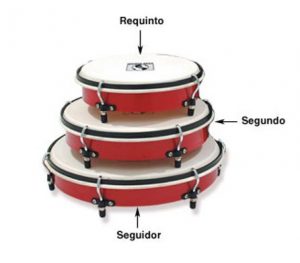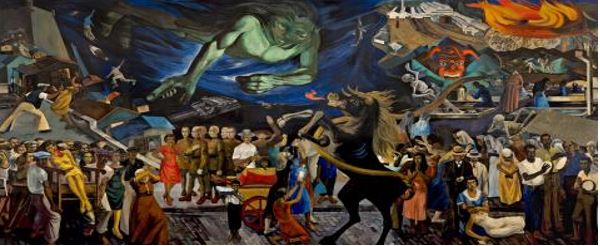This post is also available in:
 Español
Español
In the early 1900’s, a man that traveled from the West Indies to Puerto Rico looking for work, brought with him a hand-held drum; the first known “pandero”.
This event planted the first seeds of the rhythm of Plena.
Plena: a mix of Immigrants, Bomba, Danza, etc.
Ponce took a leading place in the economy of Puerto Rico since the mid 1800’s. It’s port became the main source of imports and exports for commercial goods and even for laborers. As the Caribbean got rid of slavery in the 2nd half of the 19th century, free laborers began to move around. Ponce was a magnet due to its buoying economy.
A couple from the West Indies arrived in Ponce around 1905. John Clark and Catherine George (a.k.a. Doña Catín) arrived to small slum of La Joya del Castillo. There, they began to play their hand drum, perhaps the first version of the pandero.
It turns out that the arrivals of the “ingleses” (the Englshmen) was just the spark. The rhythm they played with their panderos quickly merged with local rhythms of Bomba and Danza.
Bomba, particularly the Holandé, which was developed in the south, probably had much influence in the development of Plena. Their rhythmical patterns are very similar, and I would assume the Plena adapted the Holandé patterns to the easier playing style on the pandero.
Note: Giovanni Hidalgo talks about and demonstrates the similitudes of the Bomba Holandé with the Plena in the video embedded in Part 4: Types of Bomba.
However, Plena had other influences. The guiro used in Plena was probably a heritage of the prevalent Danza. Danza was also music mostly developed in the south. The accordion used might have come from German immigrants and was popular among the poor throughout Latin America.
The Instruments of Plena; Pandero and more
So as you can see, Plena is a rhythm that can be played with a few simple instruments.
The panderos, also and perhaps mistakenly called panderetas, are the handheld drums that constitute the main instruments. The basic format is with panderos of two sizes, but it later developed into three different sizes.

The “requinto” is the pandero that does the solos and is the smallest one. The “seguidor” is the bigger pandero. It establishes the basic and steady pattern of Plena. Upon this basic pattern established by the “seguidor“, the “requinto” does its improvisational solos.
Then there’s the addition of an intermediate-size pandero called the “segundo“. It keeps a more rhythmic pattern than the “seguidor” without improvising like the “requinto“.
The “güiro” or “güícharo” is a known instrument used in typical Puerto Rican music of “Seis“. It’s also a main instrument in the “Danza“.
The accordion and the guitar provide the melody to the Plena. They bring the essence of Plena to a very danceable form.
Plena Lyrics
Popular wisdom has it that Plena used to be the newspaper of the people. Of the poor, and perhaps illiterate people; that is.
But Ramón Lopez, in his book “Los Bembeteos de la Plena Puertorriqueña” makes the valid argument that Plena isn’t as much a newspaper as it is more like gossip, or “bembeteos“. These are funny, sometimes ironic, sometimes exaggerated stories of events that occurred in the daily life of the people in the community.
Events like when a woman got cut in a fight at a Plena dance, the visit of a bishop from Rome, or the passing of a storm through the island, served as inspiration for famous Plenas. These Plenas, however, had fewer traits of news and more of “bembeteos“.
As Plena reflected the events of the daily life of the poor people that developed it, some songs were about labor issues. Some related to strikes or unjust labor conditions. These themes, along with its portability, made Plena the genre of choice to musicalize labor chants during strikes and other events.
As Lopez argues in his book, Plena lacks the characteristics of a newspaper. The main argument for it being a “newspaper” is that there were a lot of illiterate people at the time it was developed. Although this is true, most streets, even in slums like La Joya del Castillo, had literate people that could pass the news along to their illiterate neighbors.
Pioneers of Plena
In our next blogs, I’ll get into the pioneers of Plena, and then those who continued to carry the flag to keep it alive until now.
I would love to hear your comments about this blog series so far.


[…] In the early 20th century a few conditions were changing in Puerto Rico that began to erode the popularity of “Bomba“. […]
[…] Giovanni has approached his illness with a lot of spirituality. He shared his ups and downs, but mostly how his mindset is one of perseverance to continue to provide good music. […]